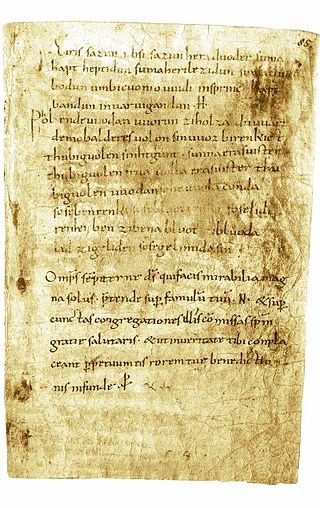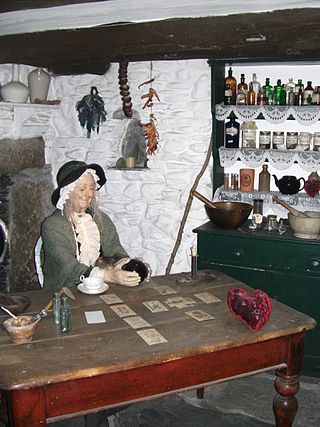Related Research Articles

A grimoire is a textbook of magic, typically including instructions on how to create magical objects like talismans and amulets, how to perform magical spells, charms, and divination, and how to summon or invoke supernatural entities such as angels, spirits, deities, and demons. In many cases, the books themselves are believed to be imbued with magical powers. The only contents found in a grimoire would be information on spells, rituals, the preparation of magical tools, and lists of ingredients and their magical correspondences. In this manner, while all books on magic could be thought of as grimoires, not all magical books should be thought of as grimoires.
Witchcraft is the use of alleged supernatural powers of magic. A witch is a practitioner of witchcraft. Traditionally, "witchcraft" means the use of magic or supernatural powers to inflict harm or misfortune on others, and this remains the most common and widespread meaning. According to Encyclopedia Britannica, "Witchcraft thus defined exists more in the imagination", but it "has constituted for many cultures a viable explanation of evil in the world". The belief in witchcraft has been found throughout history in a great number of societies worldwide. Most of these societies have used protective magic or counter-magic against witchcraft, and have shunned, banished, imprisoned, physically punished or killed alleged witches. Anthropologists use the term "witchcraft" for similar beliefs about harmful occult practices in different cultures, and these societies often use the term when speaking in English.

The Carmen Arvale is the preserved chant of the Arval priests or Fratres Arvales of ancient Rome.
In the fictional universe of Harry Potter, magic is depicted as a supernatural force that overrides the laws of nature. In humans, magical ability is inborn and is usually inherited. Most children of magical parents are magical themselves. Some children of "Muggle" (non-magical) parents also display magical ability. Children who are born to wizard parents but are unable to perform magic are known as Squibs.
The Carmen saeculare is a Latin hymn written by Horace and commissioned by Augustus. It was sung by a choir of girls and boys at the secular games in 17 BC. It is written in Sapphic meter and follows the themes of the poets of the day, in particular Vergil.

An incantation, a spell, a charm, an enchantment, or a bewitchery, is a magical formula intended to trigger a magical effect on a person or objects. The formula can be spoken, sung, or chanted. An incantation can also be performed during ceremonial rituals or prayers. In the world of magic, wizards, witches, and fairies are common performers of incantations in culture and folklore.

Witchcraft has been present throughout the Philippines even before Spanish colonization, and is associated with indigenous Philippine folk religions. Its practice involves black magic, specifically a malevolent use of sympathetic magic. Today, practices are said to be centered in Siquijor, Cebu, Davao, Talalora, Western Samar, and Sorsogon, where many of the country's faith healers reside. Witchcraft also exists in many of the hinterlands, especially in Samar and Leyte; however, witchcraft is known and occurs anywhere in the country.
A witch's ladder is a practice, in folk magic or witchcraft, that is made from knotted cord or hair, that normally constitutes a spell. Charms are knotted or braided with specific magical intention into the cords. The number of knots and nature of charms varies with the intended effect.

The Merseburg charms, Merseburg spells, or Merseburg incantations are two medieval magic spells, charms or incantations, written in Old High German. They are the only known examples of Germanic pagan belief preserved in the language. They were discovered in 1841 by Georg Waitz, who found them in a theological manuscript from Fulda, written in the 9th century, although there remains some speculation about the date of the charms themselves. The manuscript is stored in the library of the cathedral chapter of Merseburg, hence the name.

A galdr or ġealdor refers to a spell or incantation in Old Norse and Old English respectively; these were usually performed in combination with certain rites.
Chrestomanci, sometimes branded The Worlds of Chrestomanci, is a heptalogy of children's fantasy books written by British author Diana Wynne Jones, published from 1977 to 2006. In the context of the parallel universe setting of the books, Chrestomanci refers to both the British government office that is responsible for supervising the use of magic and Chrestomanci Castle in southern England, which is both residence and headquarters.

Magic in the Greco-Roman world – that is, ancient Greece, ancient Rome, and the other cultures with which they interacted, especially ancient Egypt – comprises supernatural practices undertaken by individuals, often privately, that were not under the oversight of official priesthoods attached to the various state, community, and household cults and temples as a matter of public religion. Private magic was practiced throughout Greek and Roman cultures as well as among Jews and early Christians of the Roman Empire. Primary sources for the study of Greco-Roman magic include the Greek Magical Papyri, curse tablets, amulets, and literary texts such as Ovid's Fasti and Pliny the Elder's Natural History.
Segen is a German word translating to "blessing, benediction; charm; prayer; spell, incantation".

In ancient Roman religion and magic, the fascinus or fascinum was the embodiment of the divine phallus. The word can refer to phallus effigies and amulets, and to the spells used to invoke his divine protection. Pliny called it a medicus invidiae, a "doctor" or remedy for envy or the evil eye.
The Medicina Plinii or Medical Pliny is an anonymous Latin compilation of medical remedies dating to the early 4th century AD. The excerptor, saying that he speaks from experience, offers the work as a compact resource for travelers in dealing with hucksters who sell worthless drugs at exorbitant prices or with know-nothings only interested in profit. The material is presented in three books in the conventional order a capite ad calcem, the first dealing with treatments pertaining to the head and throat, the second the torso and lower extremities, and the third systemic ailments, skin diseases, and poisons.

Khatha, or "Gatha", as originally called in Pali Language), is the Khmer and Thai name used for Sacred Pali prayers, mantras and other magical incantations. Khatha are used in general by Thai people for a great many purposes; be it for protection, charm or business ventures, there is a Khatha which can be summoned. The word Khatha, or "Gatha" in Pali, means "Speech", and thus the original meaning of the word implies that Khatha were used only as spoken language, and not written form. In spite of this fact, the word Khatha is used to refer to both that which is spoken, and also written.

Cunning folk, also known as folk healers or wise folk, were practitioners of folk medicine, helpful folk magic and divination in Europe from the Middle Ages until the 20th century. Their practices were known as the cunning craft. Their services also included thwarting witchcraft. Although some cunning folk were denounced as witches themselves, they made up a minority of those accused, and the common people generally made a distinction between the two. The name 'cunning folk' originally referred to folk-healers and magic-workers in Britain, but the name is now applied as an umbrella term for similar people in other parts of Europe.
In Bavarian folklore of the Early Modern period, a Wolfssegen was an apotropaic charm against wolves; conversely, a Wolfbann (Wolf-Bann) was a malevolent spell causing a wolf attack.

Gaius Furius Chresimus, or Cresimus, or Cressinus, was a 2nd-century BC Greek farmer and freedman in the Roman Republic mentioned in a fragment of the lost history of Lucius Calpurnius Piso Frugi, preserved in Pliny's Natural History. Piso tells that Furius Chresimus was acquitted of accusations of witchcraft during the aedileship of Spurius Postumius Albinus, dated 191 BC. The trial took place in a period of reaction against the growing influence of Hellenism at Rome, notably led by Albinus. Both Piso and Pliny told the story of the trial for its moralizing aspect.
Tibullus book 1 is the first of two books of poems by the Roman poet Tibullus. It contains ten poems written in Latin elegiac couplets, and is thought to have been published about 27 or 26 BC.
References
- ↑
 This article incorporates text from a publication now in the public domain : Chambers, Ephraim, ed. (1728). "Carmen". Cyclopædia, or an Universal Dictionary of Arts and Sciences (1st ed.). James and John Knapton, et al.
This article incorporates text from a publication now in the public domain : Chambers, Ephraim, ed. (1728). "Carmen". Cyclopædia, or an Universal Dictionary of Arts and Sciences (1st ed.). James and John Knapton, et al. - ↑ Lewis, C. T. & Short, C. 1879, A Latin Dictionary, New York: Harper and Brothers; see the entry under carmen.
- ↑ "Charm | Origin and meaning of charm by Online Etymology Dictionary".
- 1 2 3 4 Burriss, Eli Edward. Taboo, Magic, Spirits: A Study of Primitive Elements in Roman Religion . New York, Macmillan Company. 1931. Public domain.
- ↑ "Pliny the Elder, the Natural History, BOOK XVIII. THE NATURAL HISTORY OF GRAIN., CHAP. 8.—MAXIMS OF THE ANCIENTS ON AGRICULTURE".